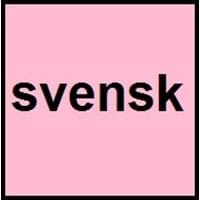Cantonese vs Swedish
Countries
Hong Kong, Macau
European Union, Finland, Nordic Council, Sweden
National Language
China, Guangdong
Sweden
Second Language
Not spoken in any of the countries
Finland
Speaking Continents
Asia
Antartica, Europe
Minority Language
Hawaii
Australia, Belgium, Canada, France, Germany, Netherlands, Spain, Switzerland, United Kingdom, United States of America
Regulated By
Civil Service Bureau, Government of Hong Kong, Official Language Division
Institute for the Languages of Finland, Swedish Academy, Swedish Language Council
Interesting Facts
- Cantonese have lot of slangs, many of them include words that do not make sense at all and some also have English in them.
- Even though Cantonese and Mandarin are dialects of Chinese, Cantonese has 8 tones instead of Mandarin's 4.
- In Swedish language, article comes after noun.
- Most of the words in Swedish language began "S" than any other letter.
Similar To
Chinese Language
Norwegian and Danish Language
Derived From
Not Available
Old Norse Language
Alphabets in
Cantonese-Alphabets.jpg#200
Swedish-Aphabets.jpg#200
Scripts
Chinese Characters and derivatives
Latin
Writing Direction
Left-To-Right, Horizontal, Top-To-Bottom
Left-To-Right, Horizontal
How Are You?
你好吗?
hur mår du
Good Evening
晚上好
god kväll
Good Afternoon
下午好
god eftermiddag
Good Morning
早上好
god morgon
I Love You
我爱你
jag älskar dig
Excuse Me
原谅我
ursäkta mig
Dialect 1
Guangzhou
Dialects
Where They Speak
outside mainland China
Gabon
How Many People Speak
Not Available
Dialect 2
Xiguan
Dialects
Where They Speak
Hong Kong
Georgia
How Many People Speak
Not Available
Dialect 3
Hong Kong
Dialects
Where They Speak
Hong Kong
France
How Many People Speak
Not Available
Second Language Speakers
Not Available
Native Name
Kwang Tung Wa
Svenska
Alternative Names
Guangfu, Metropolitan Cantonese
Ruotsi, Svenska
French Name
Not Available
suédois
German Name
Not Available
Schwedisch
Pronunciation
Not Available
[ˈsvɛ̂nskâ]
Ethnicity
Not Available
Swedes, Finland Swedes
Origin
17th century
13th Century
Language Family
Sino-Tibetan Family
Indo-European Family
Subgroup
Not Available
Germanic
Branch
Not Available
Northern (Scandinavian)
Early Forms
No early forms
Old Swedish
Standard Forms
Standard Cantonese
Standard Swedish
Language Position
Not Available
Signed Forms
Not Available
Tecknad svenska, ("Signed Swedish")
Scope
Not Available
Individual
ISO 639 1
No data available
sv
ISO 639 2/T
Not Available
swe
ISO 639 2/B
Not Available
swe
ISO 639 3
No data available
swe
ISO 639 6
Not Available
Not Available
Glottocode
cant1236
swed1254
Linguasphere
No data available
52-AAA-ck to -cw
Language Type
Not Available
Living
Language Linguistic Typology
Not Available
Subject-Verb-Object
Language Morphological Typology
Not Available
Not Available
Cantonese and Swedish Language History
Comparison of Cantonese vs Swedish language history gives us differences between origin of Cantonese and Swedish language. History of Cantonese language states that this language originated in 17th century whereas history of Swedish language states that this language originated in 13th Century. Family of the language also forms a part of history of that language. More on language families of these languages can be found out on Cantonese and Swedish Language History.
Cantonese and Swedish Greetings
People around the world use different languages to interact with each other. Even if we cannot communicate fluently in any language, it will always be beneficial to know about some of the common greetings or phrases from that language. This is where Cantonese and Swedish greetings helps you to understand basic phrases in Cantonese and Swedish language. Cantonese word for "Hello" is 您好 or Swedish word for "Thank You" is tacka dig. Find more of such common Cantonese Greetings and Swedish Greetings. These greetings will help you to be more confident when conversing with natives that speak these languages.
Cantonese vs Swedish Difficulty
The Cantonese vs Swedish difficulty level basically depends on the number of Cantonese Alphabets and Swedish Alphabets. Also the number of vowels and consonants in the language plays an important role in deciding the difficulty level of that language. The important points to be considered when we compare Cantonese and Swedish are the origin, speaking countries, language family, different greetings, speaking population of these languages. Want to know in Cantonese and Swedish, which language is harder to learn? Time required to learn Cantonese is 88 weeks while to learn Swedish time required is 24 weeks.





